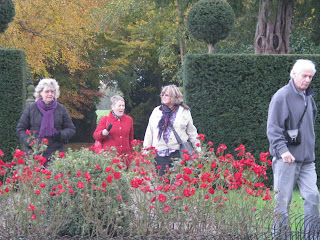


We decided to meet Wendy, Val and Jeremy at the National Trust ERDIGG near Wrecsam, it was a great Autumn day, there was a special Halloween Festival on. We all took a picnic,we all thought the house was a wonderfull recovery by the National Trust to capture the early workings of this jewel in the crown. We finally ended up with a lovely scrummy pub meal on route home.Herewith a history of ERDIGG WRECSAM.
When Joshua Edisbury was appointed as High Sheriff of Denbighshire, he decided to build a grand, new house more befitting of his status than the humble family home in which he was raised. A mile outside of Wrexham, the building of Erddig began in 1684 to the designs of Thomas Webb, and has survived with remarkably little structural change to the main core of the house. Edisbury's extravagant plans for the house, combined with his diminishing resources, eventually bankrupted him, causing him to leave Erddig, and Wales. Subsequently being purchased by John Meller, a wealthy barrister and bachelor, Erdigg remained in the family for the next 250 years or so. Extended by new wings at either end of the building to provide a Chapel and additional dressing rooms, Meller then installed many pieces of fine furniture to complete his now lavishly decorated new home.
Philip Yorke, the great nephew of Meller, and his wife Elizabeth, unarguably had the most impact on Erddig, altering the front elevation of the house, remodelling and refurbishing many of the rooms, and reorganising the estate. Among his many pursuits and interests, Philip was a dedicated historian with a developing interest in the lives of everyday people. The servants and estate workers at Erddig were always highly thought of by the Yorke family, and this relationship is amusingly demonstrated in some of Philip's artistic work. It was he who started the unusual tradition of having the servants painted, and these pictures would be accompanied by quirky little ditties composed by Philip. Many of these delightful paintings can now be seen hanging in the servants' hall and along the corridor.
During the early 19th century a large, Regency dining room was created by Philip's son and heir, Simon, and this was the last major work undertaken at Erddig, although regular maintenance of the family treasures continued. Every member of the family that lived in this vast country house had an undeniable appreciation for its history and its treasures, each in turn preserving and restoring whatever required attention. Despite this, Erdigg became severely run down after the First World War and, without sufficient money, and the onset of the Second World War, the situation deteriorated further.
The final straw came when the coal industry was nationalised in 1947, effectively taking away the estate's major source of income, and this was immediately followed by the National Coal Board's decision to mine directly under the house, compounding its declining structural state. It was only through grit and determination, not to mention some small measure of eccentricity on the part of the last two Yorke brothers, that Erddig has survived so remarkably intact.
Set in very picturesque grounds, this fascinating house of contrasts is an absolute delight to explore. Unlike many great country homes and manor houses filled with priceless art collections and exquisite furnishings, Erddig is just crammed full of treasures that say more about the different personalities of the family members.
One thing they all certainly had in common was the fact that none of them liked to throw anything away, however worthless or insignificant the article might have seemed at the time, and this adds immensely to the interest. The National Trust have recently made the attic rooms accessible and these really are the place to indulge in a good rummage around the assorted paraphernalia of a bygone era.







